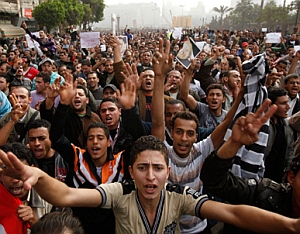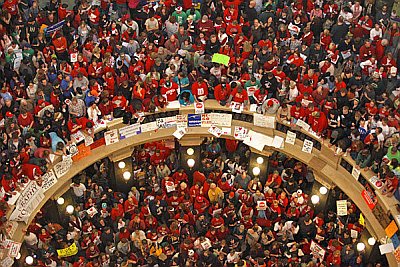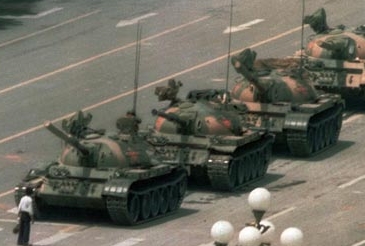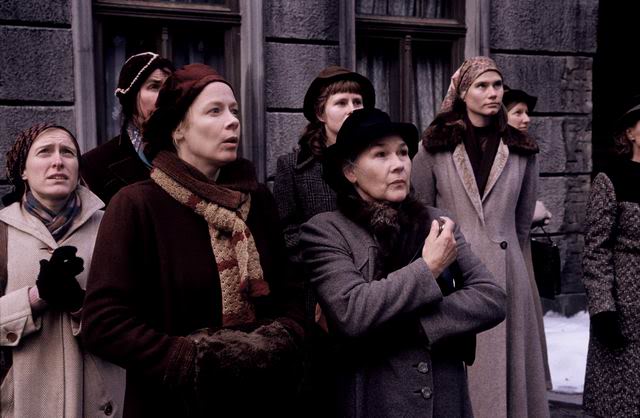From Cario, Egypt, to Madison, Wisconsin, civil society is fighting back through massive nonviolent resistance. But what makes for successful campaign?
by Erica Chenoweth, Sojourners Magazine, May, 2011

Egyptian Protest in Tahrir SquareOn Jan. 25, 2011, mass protests erupted in Egypt, with cries of “Enough is enough!” and “Wake up, wake up, son of my country. Come down Egyptians!” Although there were violent crackdowns by the Egyptian government, the overwhelming majority of protest activism was nonviolent. Eighteen days later, President Mubarak, a dictator who held power for 30 years, stepped down.
A decade into the 21st century, successful “people power” revolutions in places such as Tunisia, Egypt, Lebanon, Georgia, Ukraine, Nepal, and the Maldives have forced major changes to entrenched power by relying on “civil” resistance, a method of resistance in which civilians withdraw cooperation from oppressive regimes, often using a mixture of strikes, boycotts, sit-ins, stay-aways, and other acts of civil disobedience.

Wisconsin ProtestCivil resistance is not always the same as “nonviolence” — a practice that often evokes images of Gandhi as its main advocate. Gandhi’s approach to using mass civil resistance to oppose British dominion in the South Asian subcontinent possessed a strong moral dimension — a principled aversion to using violence. But the history of nonviolent resistance reveals that many people have relied on civil resistance not for moral reasons, but because they thought it would be an effective alternative to violence in achieving their aims.
To find out whether civil resistance is generally a more effective option than violent resistance, between 2006 to 2008 I collected data from books, encyclopedias, news reports, archives, data sets, and scholarly journals to develop a new database of mass nonviolent resistance campaigns that involved demands for regime change or territorial independence. I looked at where and when the campaigns emerged, characteristics of the opponents they faced, and whether the campaigns succeeded or failed. I then compared these findings with data on the success rates of violent insurgencies.
The results were stunning. Among 323 major violent insurgencies and nonviolent mass movements that occurred from 1900 to 2006, nonviolent campaigns were twice as effective as violent insurgencies, succeeding more than 55 percent of the time. In fact, successful nonviolent mass action has occurred in countries as diverse as Serbia, Poland, Madagascar, South Africa, Chile, Venezuela, Georgia, Ukraine, Lebanon, and Nepal.
How do nonviolent civilian-led revolutions disrupt some of the most repressive dictatorships of our time? First, nonviolent campaigns typically attract far more participants than violent campaigns. The average nonviolent campaign has more than four times as many active participants (with about 200,000) as the average violent campaign (with about 50,000). This is because nonviolent campaigns appeal to a broader section of society than violent campaigns. Tactics such as strikes, boycotts, and go-slows are available to a diverse cross section of society, including young and elderly, men and women, rich and poor, and a variety of religious and political ideologies. There are fewer moral barriers to participating in a protest or demonstration that insists on peaceful (albeit forceful) methods. Moreover, participation in civil resistance does not require a person to go underground or sacrifice one’s daily life. Although often high-risk, participation in civil resistance can be more spontaneous and anonymous because of the numbers of people involved. On the other hand, violent campaigns typically require physical strength, endurance, and agility; the willingness to sacrifice one’s day-to-day life; and the removal of any reluctance to take another life for the cause — all qualifications that exclude a large proportion of any population.
Second, when large numbers of people peacefully mobilize against repressive regimes, they often neutralize major sources of power — civilian bureaucrats, economic elites, and even the security forces.

A solitary Chinese protester
stands in front of tanks near
Tiananment Square during protest
in 1989.For example, on June 5, 1989, half a dozen Chinese tanks rolled toward Beijing’s Tiananmen Square to continue a days-long crackdown on thousands of protesters who were demanding economic and political reforms in the country’s authoritarian regime. But as they approached Tiananmen, an unknown man stood, alone, in their path, holding a shopping bag in his hand. When it became clear that the man did not intend to step aside, the lead tank lurched to a stop just a few yards from the man. After a pause, the tank pitched to the right to pass the man; but the man sprang to his left, blocking its path. The tanks that trailed also stopped, and for a few moments, the man and the tanks stood motionless in the street, facing one another in an iconic image of civil resistance. Before Tank Man’s act of noncooperation was cut short, his unarmed resolve confounded the military in ways that armed insurgents do not.
Nonviolent resistance campaigns are especially skilled at convincing security forces to stop their repression and — in some cases — to join the resistance. Because civil resistance typically includes a larger base of participants that represent a more diverse cross-section of society, security forces often identify with campaign participants through ethnic, religious, class-based, cultural, or even familial ties. Security force defections occurred in 54 percent of successful nonviolent campaigns.
Violent campaigns do not have a very good track record at convincing security forces to defect. The reason is intuitive enough. When security forces perceive a physical threat, they tend to unify to defend themselves. Imagine that Tank Man had procured a weapon from the shopping bag he was holding and fired upon the tanks as they began to move around him. No longer would Tank Man’s image represent the legitimacy and courage of the pro-democracy cause in China. Instead, he would have confronted the military on its own terms, using a method in which the military has a decided advantage. He would have been just another anonymous rebel confronting violence with violence.
The ability to divide the regime depends on careful planning, organization, training, and unity within the opposition. But once the security forces refuse to repress peaceful demonstrators, regimes tend to accommodate protesters’ demands. Note that this is not because of the moral superiority of nonviolent resistance. The reason people power works is not because the “good guys” always win. Instead, carefully planned civil resistance campaigns are able to leverage their broad participation to disrupt the regime in ways that are unavailable to smaller, violent insurgencies.

German women demand return
of Jewish husbandsA common question that often arises is: Can civil resistance succeed even against brutal opponents? What about the Nazis? There are numerous examples of nonviolent resistance against the brutal genocidal methods of the Nazi regime during World War II. One example is the Rosenstrasse protest in Berlin in March 1943. Following Hitler’s military defeat in the battle of Stalingrad, the Nazis accelerated their “final solution,” hastening the deportation and killing of millions of Jews, Gypsies, prisoners of war, and others. In Berlin, SS paramilitary troops detained nearly 2,000 Jewish men who had previously been spared because their wives were non-Jewish Germans. Their wives began to gather outside of the building on Rosenstrasse where the men were detained. Day and night, the women occupied the streets and chanted “Give us our husbands back.” Ultimately, hundreds — if not thousands — of people joined the protest, even as SS guards mounted machine guns and threatened to fire upon the protesters. The protest lasted a week. At the end of the week, the SS released the men. Almost all of the men lived to see the end of the war.
This remarkable event demonstrates the power of organized, nonviolent direct action — even against the most brutal dictatorships. A simple inscription on the “Block der Frauen” (“Block of Women”) memorial in Berlin bears witness: “The strength of civil disobedience, the vigor of love overcomes the violence of dictatorship. Give us our men back. Women were standing here, defeating death. Jewish men were free.”
And, in fact, the overall trend suggests that even in situations where regimes used violence to crack down on resistance campaigns, 46 percent of nonviolent campaigns have prevailed, whereas only 20 percent of violent campaigns succeeded against these violently repressive states.
The data tells us a few things that we didn’t know before. First, there is little truth to the claim that insurgents must use violence in order to get what they want. Many observers maintain that people resort to violence when they are forced to do so — by overly repressive circumstances, by injustices they can no longer tolerate — and after exhausting all other means of political influence.
One hears this claim quite a lot from insurgents, scholars, and pundits, who argue that Sunni insurgents in Iraq, the Afghan Mujahideen, or even El Salvador’s Farabundo Martí National Liberation Front had to choose violence to wage their struggles because it was the only way they had a chance to succeed. Gandhi himself — the quintessential pacifist — once articulated that “It is better to be violent, if there is violence in our hearts, than to put on the cloak of nonviolence to cover impotence.” Contrary to these assumptions, nonviolent resistance has proved to be a much more powerful way to achieve political goals, even in brutally repressive environments.
Second, civilian-led nonviolent resistance can divide and topple regimes as security forces grow weary of repressing their unarmed compatriots. The more diverse the campaign, the more likely it is to produce security force defections. Any campaign that is overly homogenous (for example, relying on a strong religious component without wider appeal) will have difficulty succeeding because it will not attract a wide enough portion of the population to provide varied points of access to potential allies within the regime. For instance, an urban revolution often will gain little sympathy from regime functionaries who come from the countryside.
Third, and perhaps most surprising, material support from foreign states has little effect on the success of nonviolent campaigns. Only 10 percent of nonviolent campaigns have received direct material support from foreign governments, and in those cases, it may have caused disunity within the campaign or undermined the movement’s legitimacy in the eyes of potential grassroots supporters. As national security expert Richard K. Betts said recently in response to how the U.S. security establishment should react to the protests in Egypt, “Popular revolutions can hardly ever be contained or channeled effectively by foreign forces.” But moral support — such as naming and shaming the oppressive regime’s abuses, cutting off financial or military support to the regime, and making diplomatic statements in support of the movement — can encourage participants to maintain enthusiasm and commitment.
Overall, the data provides hard evidence that nonviolent resistance is anything but passive or weak. Gandhi was right when he said, “Nonviolence is a weapon of the strong.” As we watch events unfold in the Arab world and elsewhere, we should keep in mind that calls to use violence to confront oppressive regimes are almost never justified by necessity. Skillful applications of “people power” have been the most robust and reliable forces for change in the world since World War II, and this trend is likely to continue well into the 21st century.
Erica Chenoweth is an assistant professor of government at Wesleyan University and co-author with Maria J. Stephan of the forthcoming book Why Civil Resistance Works: The Strategic Logic of Nonviolent Conflict.